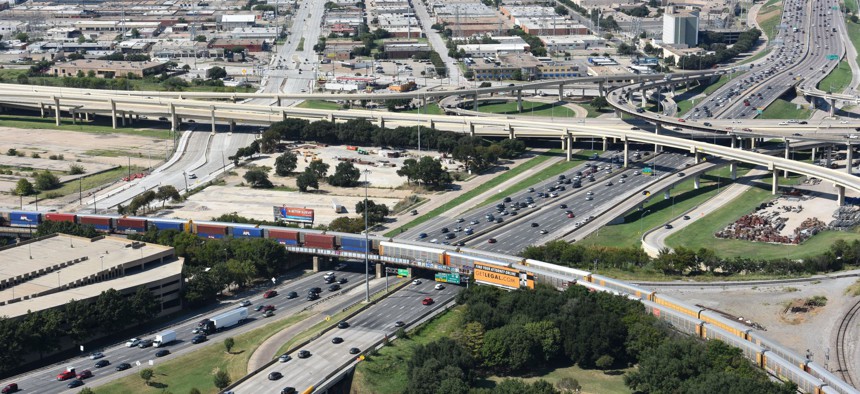The Trillion Dollar Question Hanging Over Public-Private Partnerships

The junction of Interstate 35E and the Woodall Rogers Freeway near downtown Dallas. Shutterstock

Connecting state and local government leaders
With Trump’s infrastructure plans still unclear, this week’s P3C Public-Private Partnership Conference & Expo in Texas is looking at the what ifs. One speaker noted: “an infrastructure plan is not something that can be done by executive order.”
DALLAS — Call it a trillion dollar question.
As industry and government leaders with an interest in public-private partnership deals gathered here Monday, significant attention was directed toward Washington, the Trump administration and what any eventual federal legislation for new infrastructure investment could look like.
“We have a president that’s pledged to do a 10-year, one-trillion dollar program that is going to have public-private partnerships as a very prominent feature,” said Dale Bonner, executive chairman of Plenary Concessions, a public infrastructure investor and operator.
“We’re all focused on that,” Bonner added, during opening remarks at the P3C Public-Private Partnership Conference & Expo, which is happening in Dallas this week. But he noted that details are for now limited. “It’s very unclear still really what the proposal will be.”
Speaking to governors Monday, Trump repeated his promise for “big” new spending on U.S. infrastructure, lamenting the condition of the nation’s aging roads, bridges and tunnels. But how the president will work with Congress to deliver this investment is uncertain.
“An infrastructure plan is not something that can be done by executive order,” said Jill Jamieson, group managing director for public institutions at Jones Lang LaSalle, a company that works on partnership deals involving real estate at the local, state and federal levels of government.
Shant Boyajian is an attorney with Nossaman LLP, a law firm that bills itself as having played a “role in almost every major, innovatively financed U.S. transportation infrastructure project.”
Boyajian previously served as senior counsel to the U.S. Senate Committee on Environment and Public Works.
On Monday, he highlighted what is sure to be a core element in any debate about infrastructure funding and financing in Washington. “The fact of the matter is that any direct spending the federal government wants to do, or anything that impacts the bottom line to the tax base,” he said, “is going to require some kind of offset, either increased revenue or cuts elsewhere.”
Some information about how the president’s infrastructure proposals could look is outlined in a report issued by Trump’s advisers last October during the presidential campaign—the Senate confirmed one of those advisers, investor Wilbur Ross, as Commerce secretary Monday. The paper suggested federal tax incentives could help spur new private investment in projects.
Jamieson said tax credits should help to lower the required return on investment and financial costs of public-private partnerships, making them more attractive to governments that can borrow at relatively low interest rates through the municipal bond market.
That said, it would be misguided, according to Jamieson, to assume whatever infrastructure package emerges would call only for public-private partnerships and no direct federal funding.
But she later added: “You’re going to see people extracting value from existing assets unlike anything we’ve seen in the past.”
Regarding the state and local level, she said she’d heard “some crazy stuff” about what could occur under a federal infrastructure proposal. For instance: conditioning one-third of federal funding on doing public-private partnerships.
“That’s not going to happen,” she said. “State and local governments will be on their own in terms of deciding what they want to P3 and not P3.”
Cutting regulatory obstacles for projects, such as those that have to do with environmental permitting, is expected to be another priority on Trump’s agenda.
“Just looking at who the president has named to some of these cabinet appointments, they’re very skeptical of the regulatory process,” Boyajian said. He said he would be “shocked” if the administration’s infrastructure proposals did not seek to address this area.
Some of those on hand at the conference from government agencies indicated they were not focused too much in the near term on how Trump’s infrastructure plans shake out.
“We’re obviously looking at the federal government, funding would help,” said Jose Galan, director of the Miami-Dade County Internal Services Department’s real estate development division. But he added: “The projects that we’re looking at now are things that we can do on our own.”
“Anything that Washington does, it’s kind of a wait-and-see approach right now,” Galan said.
Seth Miller Gabriel, director of the District of Columbia’s Office of Public-Private Partnerships, echoed Galan’s view.
“We’re really focused on what we can do independent of the federal government,” he said, “due to the uncertainty of what’s going to happen with this infrastructure plan, if there is one.”
Bill Lucia is a Senior Reporter with Government Executive’s Route Fifty and is based in Washington, D.C.
NEXT STORY: Digging out from under records requests





